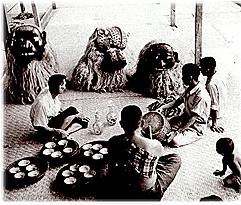The religious practice in Luang Prabang is a mixture of
animist beliefs and Buddhism; the former having evolved from prehistoric beliefs and
creation myths.Outstanding natural sites embodied in large trees, big rocks and rapids,
where the fifteen nagas (royal protectors of the town) live; as well as the sacred Phou Si
hill, are worshipped. The creation myths refer to the creation of the spirit idealized in
local folklore.
Examples are the numerous cults in Luang Prabang addressed to the Phi (either good or
evil spirits), or to Pou Gneu Gna Gneu, the tutelary spirits of Luang Prabang, whom the
myths designate as the ‘Organizers of its territory'. This explains the presence of ho
phi, shrines dedicated to the guardian spirit, to whom offerings are made within the
grounds of ever monastery and in front of some houses.
The local inhabitants visit the town's numerous temples daily where the monks are from
the Theravada (Lesser Vehicle) school of Buddhism that replaced that of the Mahayana
(Great Vehicle); in practice until the mid XlVth century. The Laotian lunar calendar has
twelve months a year. For certain years there are thirteen months; in which case the
eighth month will be doubled. The calendar regulates religious and animistic festivals. Of
a domestic nature, the festival of the third month is accompanied by an agricutural
ceremony
During the fourth month, Boun Phavet or ‘Festival of the Ultimate Existence' is a
holy festival, the Vessantara, the ultimate incarnation of the future Buddha, recited.
In Luang Prabang the return to the beginning of the kingdom and the cosmos is sought
after during the New Year festival. For this occasion the town observes a series of
ceremonies over several days: religious services, the giving of offerings, prayers,
processions, building of small sand stupas, spirit worship and nocturnal festivals.
There are two New Year Days - the first is in December and marks the change of the
zodiac cycle, which is based on the lunar calendar. The second is in April and marks the
beginning of the civil year; this is calculated by the solar calendar and is solemnly
celebrated in the fifth month. During the last three days of the year, ceremonial
elephants are circulated in procession around the town where they pay homage to the
guardian spirits at Vat Vixun, Vat May and Vat Xieng Thong.


